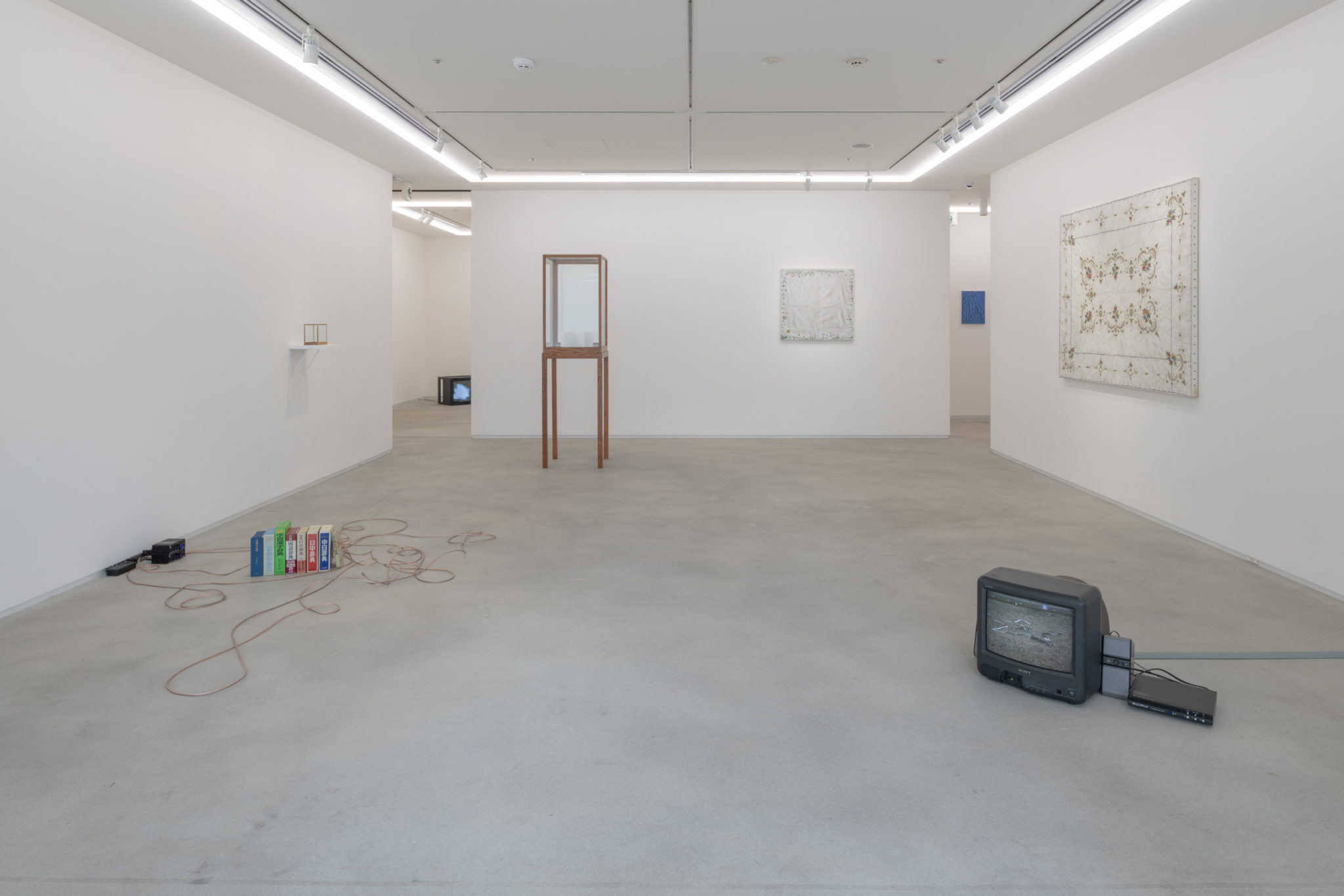Art critic and scholar. Nakao holds a PhD in art and writes criticism on modern and contemporary art. He takes a particular interest in the connections between living (or non-art) and creative practice from the perspective of chess, one of Marcel Duchamp’s favorite pastimes, and is the author of Marcel Duchamp and Chess (Heibonsha, 2017). He is co-author and editor of Sports/Art (Shinwasha, 2020), and has curated exhibitions including “Medium and Dimension: Liminal” (held at Kakinosou in Tokyo, 2022). Nakao is a part-time lecturer at Joshibi University of Art and Design, Tama Art University, Tokyo University of the Arts, Tokyo Institute of Technology, and Rikkyo University. https://nakaotakuya.com
Installation view of “Everywhere Gather Yourself Stand” (2022) at SCAI PIRAMIDE, Tokyo. Photo by Nobutada Omote. Courtesy the artist and SCAI THE BATHHOUSE
Unraveled, spun together, on those lines
Time and space emerge when the position of an object is connected to the position of another. What words can we use to describe the time-space that arises as if its parts were linked, even though no such result were obvious? Perhaps an apt comparison would be constellations, which are recognized as linkages of stars when observed from a certain point—Earth—despite occupying different locations in time and space in the vastness of the universe. This follows Walter Benjamin, who employed the concept of “constellation” in the sense of arrangements or situations (referring to certain positional relationships in time and space) to describe the relationship between ideas and objects. Ideas enable us to perceive relations between objects, just like constellations allow for positive connecting of clusters of stars shining against the negative backdrop of the night sky.
“Everywhere Gather Yourself Stand,” the sharply worded title of this exhibition, comes from the poem Eye-glances by the German-Jewish poet Paul Celan, included at the beginning of Threadsuns (1968), the last of Celan’s poetry collections published before his death. Celan owned a copy of the first volume of Benjamin’s collected works, edited by Theodor Adorno and others and published in 1955, and it is interesting that he had come into contact with Benjamin’s ideas at an early stage. The poet had underlined the following passage, from the “Epistemo-Critical Prologue” in The Origin of German Tragic Drama, in his copy of Benjamin’s collected works:
“Just as the harmony of the spheres depends on the orbits of stars which do not come into contact with each other, so the existence of the mundus intelligibilis depends on the unbridgeable distance between pure essences. Every idea is a sun and is related to other ideas just as suns are related to each other. The harmonious relationship between such essences is what constitutes truth.”[1]
Celan scholar Hiroaki Sekiguchi argues that Benjamin’s key concept of “constellation” (arrangement) can be read as pointing to the essence of Celan’s poetics. In Sekiguchi’s view, “Each word in a (Celan) poem, and each poem in his collections, exists at a certain ‘distance’ from the other, but is positioned to ‘ring with truth’ like the relationship between suns.”[2] In the same sense, the words “Everywhere Gather Yourself Stand” that come from one of Celan’s poems appear to exhibit an interrelationship between their subject and that which connects them across a “distance.” Consequently, the exhibition focuses on the invisible lines or threads that are drawn to bind the stars shining in the night sky together into constellations.
It seems worth mentioning that this exhibition was held at two venues, SCAI PIRAMIDE (SCAI) (July 21–September 17) and Yutaka Kikutake Gallery (YKG) (July 7–August 6). Although the two venues are located in the same building, they are on different floors and on opposite sides, rather than on top of each other. Looking up from YKG, you can see SCAI, and if you look down from SCAI, you can catch a glimpse of YKG. Since the exhibition periods were not identical, one had to visit during the time they overlapped in order to appreciate the connection between the two locations. There were also times when only either YKG or SCAI was open, meaning that the exhibition could only be viewed at one of the venues. Was this a limitation, a condition, or what?
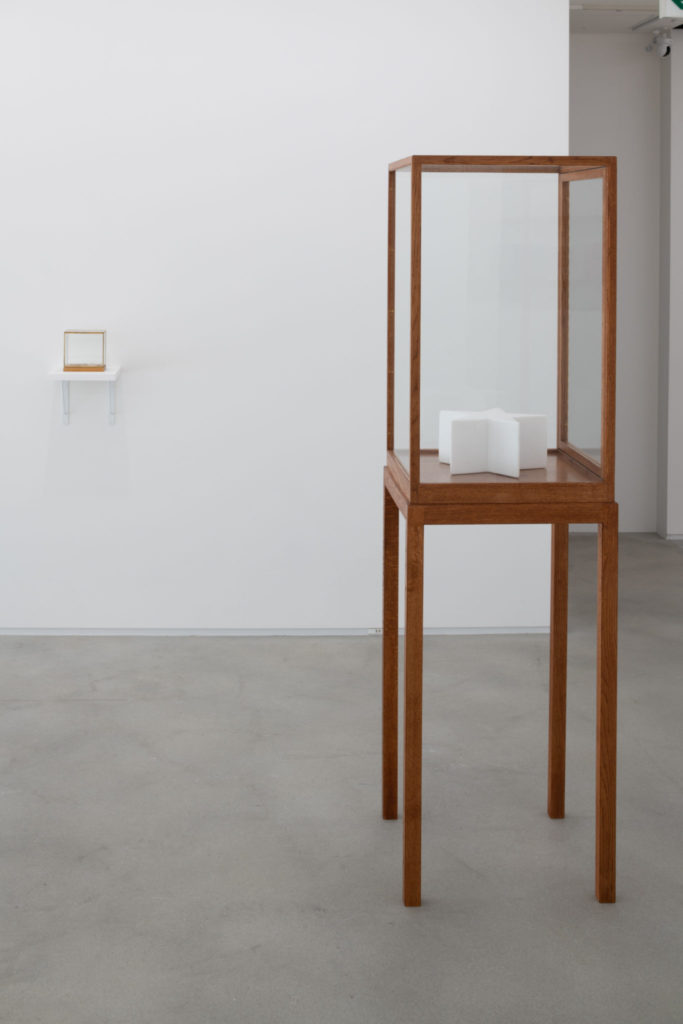
Installation view of “Everywhere Gather Yourself Stand” (2022) at SCAI PIRAMIDE, Tokyo. Photo by Nobutada Omote. Courtesy the artist and SCAI THE BATHHOUSE
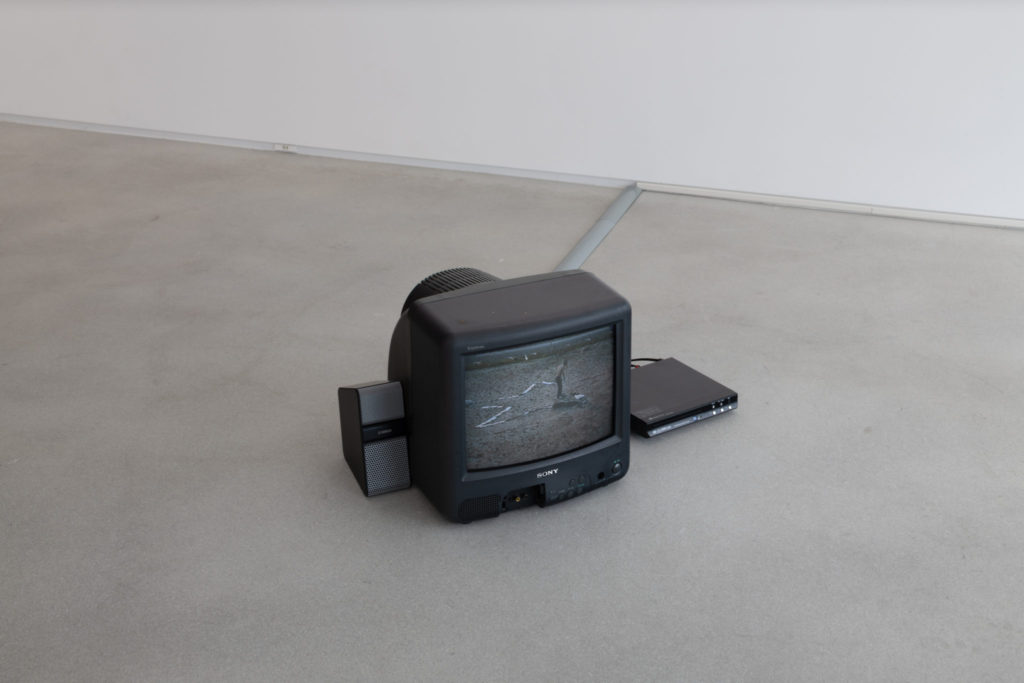
Ishu Han “My Star” 2005, Single channel video, sound, 5’33” ©Ishu Han Installation view of “Everywhere Gather Yourself Stand” (2022) at SCAI PIRAMIDE, Tokyo. Photo by Nobutada Omote. Courtesy the artist and SCAI THE BATHHOUSE
Let’s take a look at the continuity in the exhibition. One clue is contained in the connection between the star shapes in James Lee Byars’ The Figure of Question: The Star Book (1990) and Ishu Han’s My Star (2005), as described in the exhibition statement. The former is represented as a symbol of the human form by Byars, who derived formalistic beauty from mystical thoughts and meditative experiences, while the latter is represented as lines (reminiscent of the five-pointed stars on the Chinese flag) created by Han after moving from Shanghai to Aomori, by taking his possessions out of a bag and laying them out while removing his own clothes.
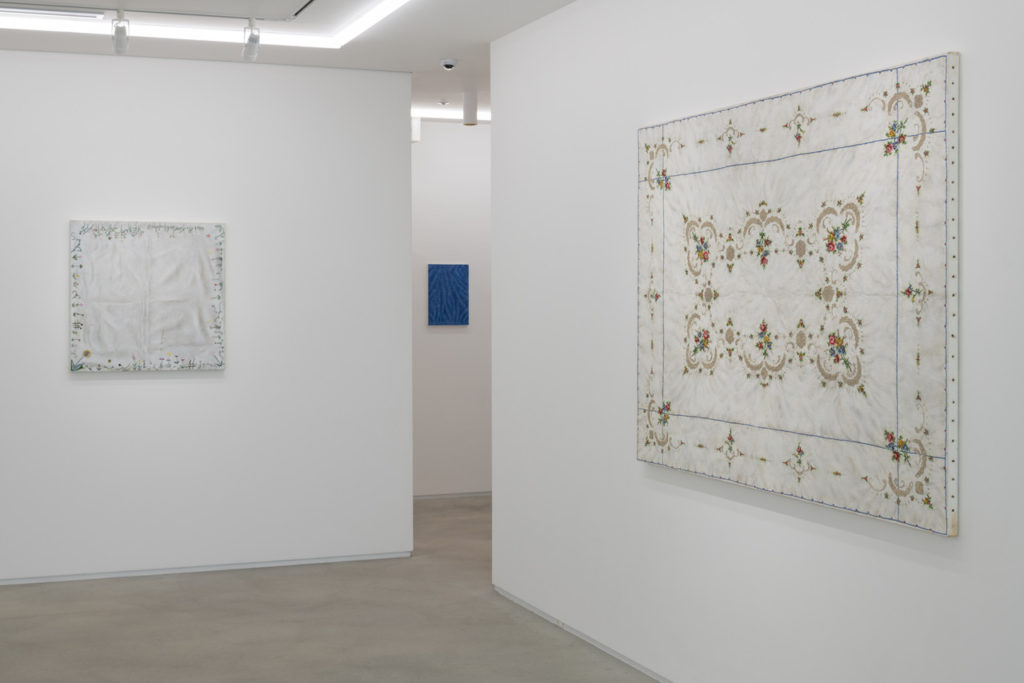
Installation view of “Everywhere Gather Yourself Stand” (2022) at SCAI PIRAMIDE, Tokyo. Photo by Nobutada Omote. Courtesy the artist and SCAI THE BATHHOUSE
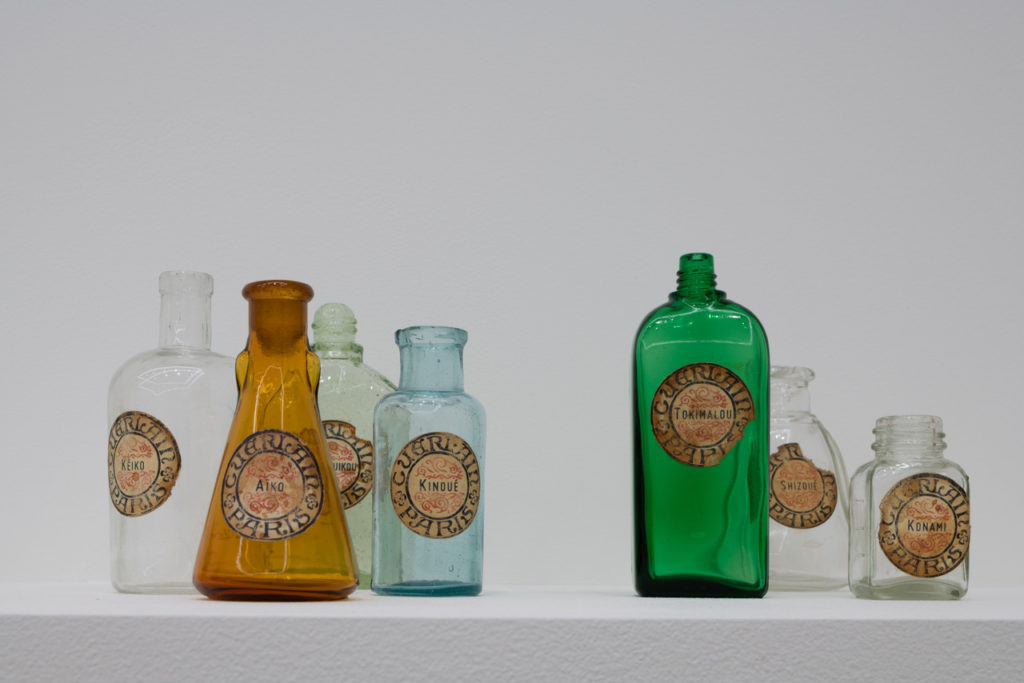
Yui Usui “empty name” 2013, mixed media Installation view of “Everywhere Gather Yourself Stand” (2022) at SCAI PIRAMIDE, Tokyo. Photo by Nobutaka Omote. Courtesy the artist and SCAI THE BATHHOUSE
Such ties extend to other works as well. The oil painting Tablecloth That My Grandmother, My Mother, and Her Two Other Sisters Made Together (2013) by Ken Sasaki depicts a work of embroidery done together by the women in the title, while in Apichatpong Weerasethakul’s film Cactus River (2012), a woman who has been given the name “Water” (Nach) following the Thai folk belief that changing one’s name can make one happy, is shown knitting a garment in a fast-forward scene. There’s also a connection between this woman and the countless used glass bottles in Yui Usui’s Empty Names (2013), which bear labels inscribed with the “professional names” given to “comfort women” who worked in the so-called comfort stations used by the Japanese military during the Pacific War (and, in my memory, the linkage extends to the cloth artwork Demands and Resistance [2019], another piece by Usui I recall having seen in a different place). The circle is completed by Sewing the words (2022), a bundle of dictionaries used by Han (with audio of Han’s grandmother working in her kitchen in Shanghai and Han’s son studying Chinese to be able to speak with his grandmother). The aforementioned linkages also seem to form a large star-shaped figure through the way they’re laid out in the exhibition space.
These artworks all occupy different points in time and space and are born from differing problematics. However, the five-pointed star in Han’s work, which was created to raise questions about his own identity following his move from Shanghai to Aomori, and the star shape in Byars’ work, which permeates the form of a human being standing or lying down with arms and legs open, overlap in terms of dealing with the human body and at a deeper level of expression. Similarly, the acts of actual knitting and the weaving together of events in daily life are elements of the same phase—of connecting the invisible threads of historical and social problematics that each piece of art here contains.
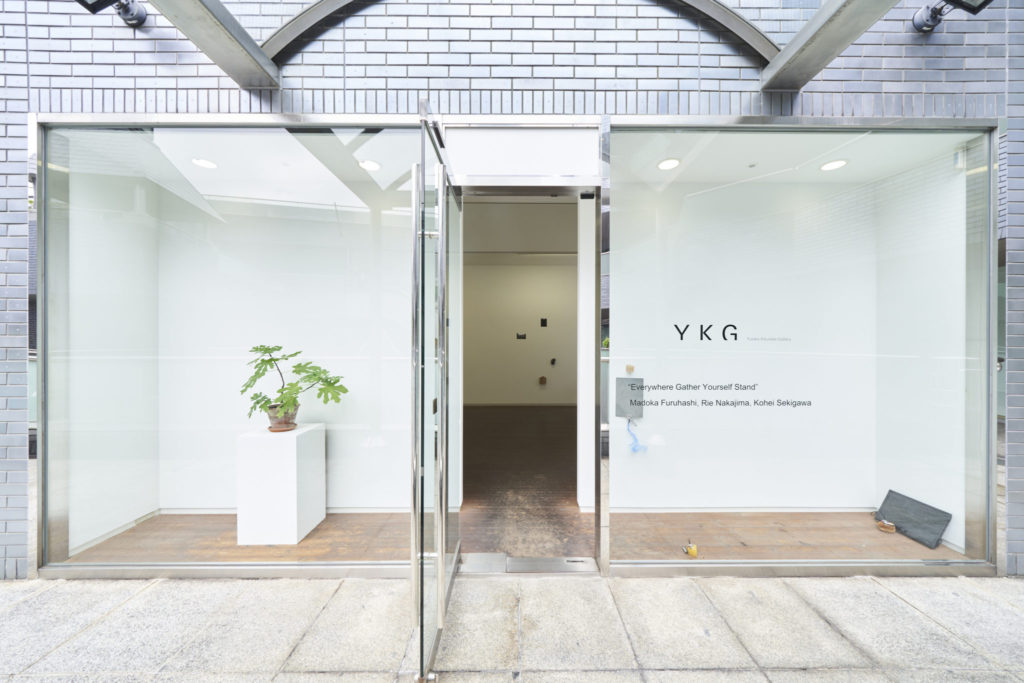
Installation view of “Everywhere Gather Yourself Stand” (2022) at Yutaka Kikutake Gallery. Photo by Osamu Sakamoto. Courtesy of Yutaka Kikutake Gallery

Madoka Furuhashi “To undebecome” 2022, white clay Installation view of “Everywhere Gather Yourself Stand” (2022) at Yutaka Kikutake Gallery. Photo by Osamu Sakamoto. Courtesy of Yutaka Kikutake Gallery
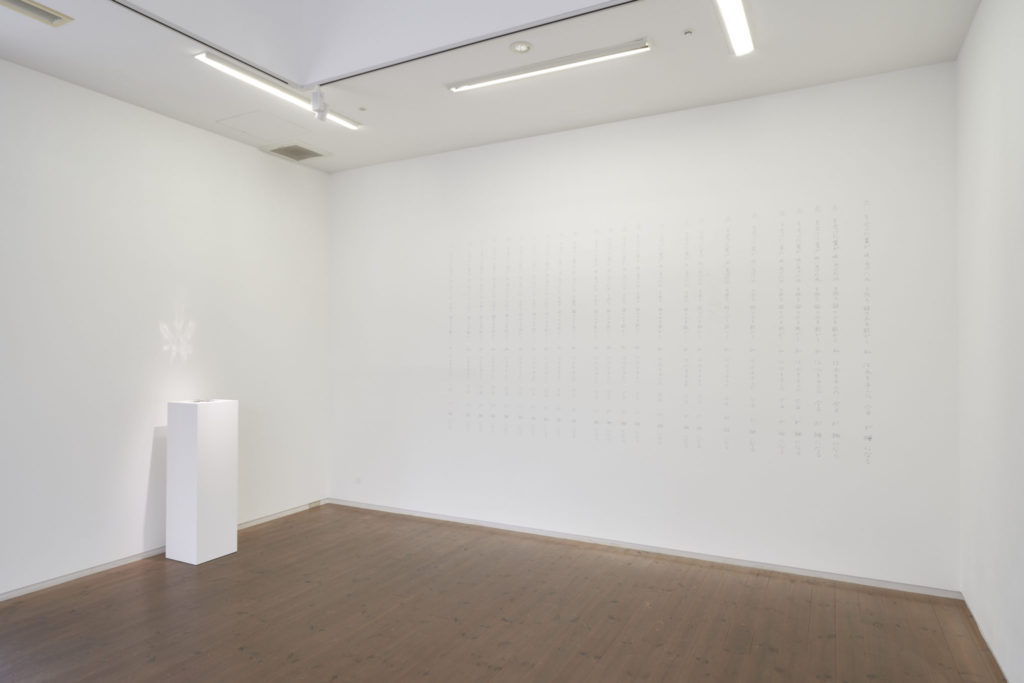
Kohei Sekigawa “I Don’t Care a Fig for…” (detail) 2022, potted fig tree, stainless steel, graphite, performance Installation view of “Everywhere Gather Yourself Stand” (2022) at Yutaka Kikutake Gallery. Photo by Osamu Sakamoto. Courtesy of Yutaka Kikutake Gallery
Such “constellation = arrangement” also came into play in relation to the works of Kohei Sekigawa, Rie Nakajima, and Madoka Furuhashi, which were exhibited at YKG. Peeking down through the glass at YKG from SCAI, visitors could see a potted fig tree that Sekigawa had been watering, sound objects that Nakajima had fashioned out of items such as scrubbing brushes and sponges, and objects that Furuhashi had created to deal with her mother’s death by digging up soil equal to her own body weight from her garden and firing the material in the shape of handfuls. At a certain point in time and space, the soil that Furuhashi had grabbed and the photographs of the plants in her garden, and the moving daily necessities that Nakajima added to her work day by day, were connected to the vertical, fence-esque sentence that Sekigawa, who visited the exhibition space every day to water his plants, wrote on the wall of the gallery: “The leaves that received light released the water they had absorbed, the soil in the pot dried, I watered it, and today will be a fence”—and linked to the verticality of the case that contained Byars’ star.
Perhaps there’s a tendency these days to avoid analyzing exhibitions in terms of such forms and actions. However, in this case, rather than being a mere series of informational links, these large interlocking rings—which can be dismantled into forms and daily activities, but also enable the emergence of common forms from different levels of information across different points in time and space—functioned as constellations, revealing both individual problematics and some of the ancient layers that humanity continues to gaze upon.
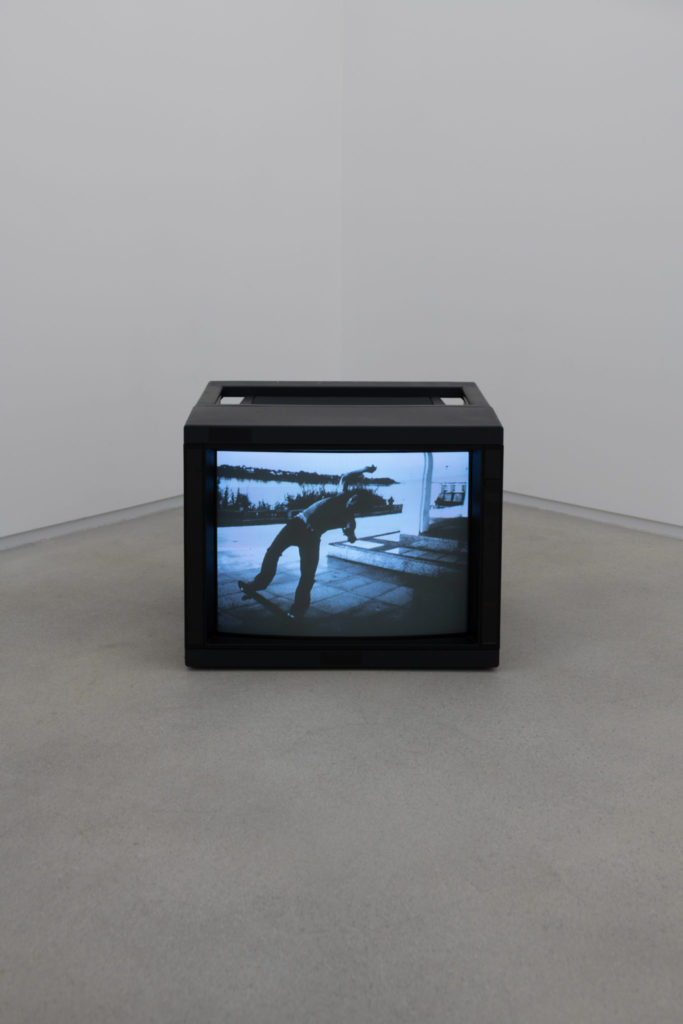
Apichatpong Weerasethakul “Cactus River” 2012, 10’9″ Installation view of “Everywhere Gather Yourself Stand” (2022) at SCAI PIRAMIDE, Tokyo. Photo by Nobutada Omote. Courtesy the artist and SCAI THE BATHHOUSE
In the “Everywhere Gather Yourself Stand” verse of Eye-glances, the poem by Paul Celan—who ended his life by throwing himself not into the riverside, the stretch of land along the river, but into the line of the Seine—there’s a clause that calls on the reader to “increate[3].” In Cactus River, the woman is shown walking (in slow motion) along the banks of the Mekong River, one decelerated frame at a time. A man skateboarding by the riverside fails a backside 180 down a two-step staircase. To be precise, he fails to land, but regains his position with perfect balance and does not fall. The woman is staring at him. Or, rather, a frame that makes it look like she’s watching is shown in slow motion, but whether she was actually paying attention isn’t clear.
Seemingly, the most striking thing about this exhibition is not the stars floating in the darkness—i.e. the actual works, which are simply there and can be looked at—but the image of humans it evokes; wobbling and wavering on the invisible lines that connect them. The stars, shining as the bodies of information representing various problematics, are connected in “eye-glances” and “everywhere” across many different times and spaces, unraveling and being spun together as a network laid out to maintain one’s sanity or remain steady in an uncertain world, their lines echoing to form a harmonious relationship with calls to “gather yourself, stand.”
[1] Hiroaki Sekiguchi: Paul Celan und das Judentum, Keio University Press, 2011. Page 128. Quoted from Walter Benjamin, The Origin of German Tragic Drama, translated by John Osborne, Verso, 1998. Page 37.
[3] The original German word in Celan’s poem is “unentworden,” a neologism sometimes also translated as “undebecome.” Paul Celan: Threadsuns, translated into Japanese by Mitsuo Iiyoshi, Biblos, 1997. Page 10.
Translated by Ilmari Saarinen
INFORMATION
Everywhere Gather Yourself Stand
Yutaka Kikutake Gallery July 7, 2022 - August 6, 2022
Official site
SCAI PIRAMIDE July 21, 2022 - September 17, 2022
Official site


